There are over 30 venomous snake species in the United States. How many of those species live in Texas and how many live in Georgia? One of these states is the clear winner, though it is probably not a contest that many of the state’s residents would like to win!
Georgia — Six Venomous Snake Species
| Snake | Aggressiveness | Distribution |
|---|---|---|
| Copperhead | Low | Throughout the state, except for the extreme southwest |
| Cottonmouth | Medium | Bodies of water throughout the state |
| Eastern Coral Snake | Low | Coastal Plain |
| Timber Rattlesnake | Low | Throughout the state except for the extreme southwest |
| Pygmy Rattlesnake | Low | Northeast, northwest, and central Georgia |
| Eastern Diamondback Rattlesnake | Medium-High | Coastal Plain |
Georgia’s Most Common Venomous Snake
Copperheads outnumber all other venomous snakes in Georgia. Not surprisingly, they are also responsible for more snakebites than any other of Georgia’s venomous snakes. This isn’t because copperheads are overly aggressive but because there are more of them. They are also found in more populated areas, so human/copperhead interactions are higher than any of the other venomous snakes in the state. However, a copperhead bite is rarely fatal.

The copperhead is responsible for more snakebites than any other venomous snake in Georgia.
©Creeping Things/Shutterstock.com
Georgia’s Least Common Venomous Snake
The eastern diamondback rattlesnake is the least populous snake in the state. The snake is listed as a Species of Concern in Georgia. Habitat fragmentation and degradation have significantly impacted the species. Also, many eastern diamondbacks are killed whenever they are found. “Rattlesnake roundups” also harm the species, including the gassing of gopher tortoise burrows where the snakes are often found.
The Most Highly Venomous Snake in Georgia
The eastern diamondback rattlesnake is the rarest venomous snake in Georgia, but it is also the most deadly. In fact, it is the most venomous snake in all of North America. It is also the largest venomous snake on the continent, with some individuals growing upwards of eight feet long.
This snake’s venom is filled with hemotoxins (toxins that attack the blood) but also a cocktail of other toxins that attack the heart, lungs, and individual cells.
The eastern diamondback is also more likely to strike than its counterpart, the western diamondback rattlesnake. This doesn’t mean it actively seeks to bite humans, but it is more likely to strike if it feels cornered or threatened. Still, the unwarranted horror stories and sensationalism surrounding the snake have led to critically low numbers for the species in Georgia.

The eastern diamondback rattlesnake is the rarest but also the most lethal venomous snake in Georgia.
©Chase D’animulls/Shutterstock.com
Snakebites in Georgia
Hundreds of people are bitten by snakes in Georgia each year. The record number of snakebite calls to the Georgia Poison Center came in 2016, when the center received 466 snakebite calls. Of those 466 calls, 20% were treated with antivenom. Most of those were copperhead bites.
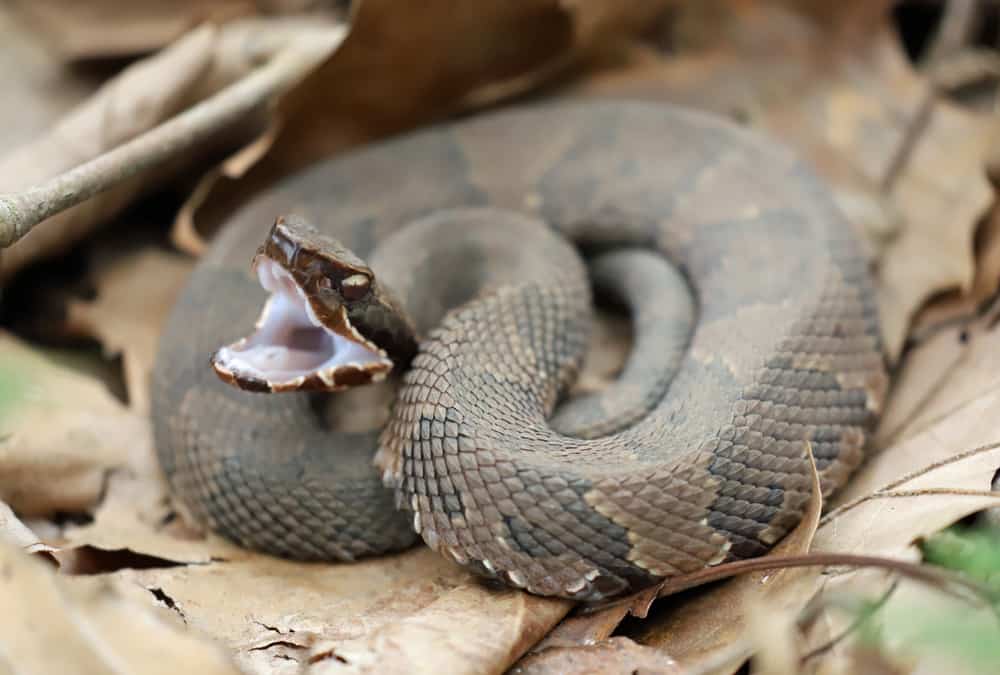
Most snakes will not bite unless they are threatened or cornered.
©KF2017/Shutterstock.com
Snake Season in Georgia
Georgia’s snakes become active in March or April. They remain active until late fall when they brumate for the winter. Brumation typically begins when temperatures dip below 65°F.
Texas — Ten Venomous Snake Species (And More Subspecies!)
Texas has ten venomous snake species but 14 total venomous snakes when all the subspecies are included. This high number isn’t surprising since Texas has more total snake species than any other state.
| Snake | Aggressiveness | Distribution |
|---|---|---|
| Black-tailed Rattlesnake | Low | Throughout Texas, except for easternmost part of the state |
| Copperhead | Low | Throughout Texas |
| Cottonmouth | Medium | Bodies of water in the eastern half of Texas |
| Massasauga | Low | North-central Texas, Southern tip of Texas |
| Mojave Rattlesnake | Low | Far west Texas |
| Prairie Rattlesnake | Low | Western half of Texas |
| Rock Rattlesnake | Low | Western Texas |
| Texas Coral Snake | Low | Southeastern Texas |
| Timber Rattlesnake | Low | The eastern third of Texas |
| Western Diamondback Rattlesnake | Medium | Throughout Texas, except for the easternmost part of the state |
| Western Pygmy Rattlesnake | Low | Eastern Texas |
Subspecies
Three of the species in the table above have multiple subspecies found in Texas.
There are three subspecies of copperheads in Texas:
- Broadbanded Copperhead
- Southern Copperhead
- Trans-Pecos Copperhead
Two rock rattlesnake subspecies are found in Texas:
- Banded Rock Rattlesnake
- Mottled Rock Rattlesnake
Texas is home to two Massasauga subspecies:
- Desert Massasauga
- Western Massasauga
Texas’ Most Common Venomous Snake
The western diamondback rattlesnake is the most common and widespread of all Texas’ venomous snakes. The snake is found in all of Texas except for the easternmost reaches of the state. This snake is also responsible for more snakebites than any other venomous snake in the Lone Star State.

The western diamondback rattlesnake is the most common of Texas’ venomous snakes.
©Audrey Snider-Bell/Shutterstock.com
Texas’ Least Common Venomous Snake
Exact numbers are impossible to discern, but the two rarest venomous snakes in Texas are probably the banded rock rattlesnake and the Mojave rattlesnake. Both are found only in the extreme western part of the state.
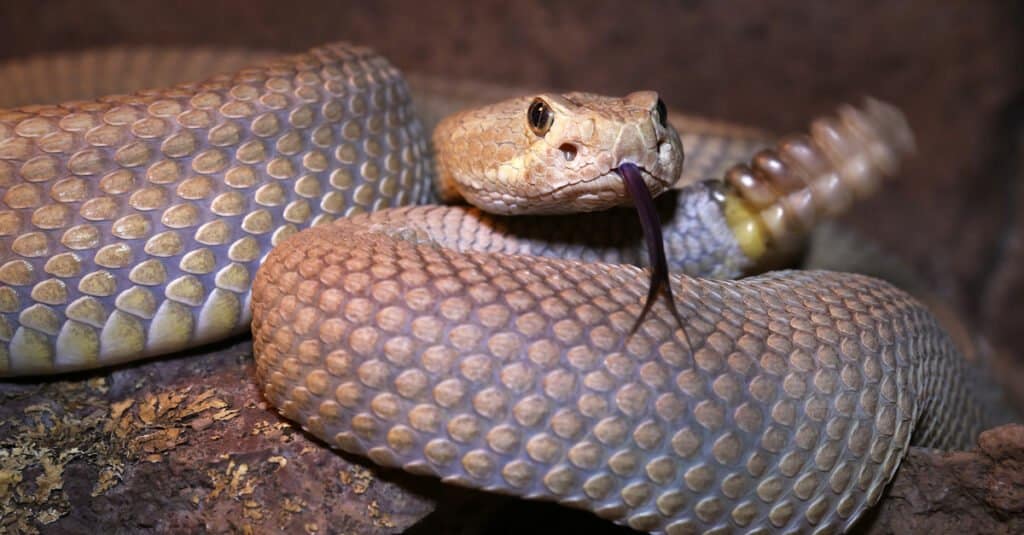
The Mojave rattlesnake is one of the rarest venomous snakes in Texas.
©Ryan M. Bolton/Shutterstock.com
The Most Highly Venomous Snake in Texas
Texas only has one venomous snake that is not a pit viper, and it is also the most toxic of all venomous snakes in the state: the Texas coral snake. However, the snake’s small mouth and its fixed fangs normally prevent it from delivering a significant bite to a human. The snake is also among the least aggressive venomous snakes in Texas. Most people who are bitten by a Texas coral snake intentionally provoked or picked up the snake.
Any bite from this snake should still be taken seriously due to its incredibly high toxicity. Thankfully due to the development of an effective antivenom, there has not been a fatal bite from a Texas coral snake since the 1960s.
The second most venomous snake in Texas, the Mojave rattlesnake, is the deadliest of all the pit vipers in the state. The venom of this snake contains potent neurotoxins and requires immediate medical attention. The snake’s rarity makes a bite highly unlikely, though.
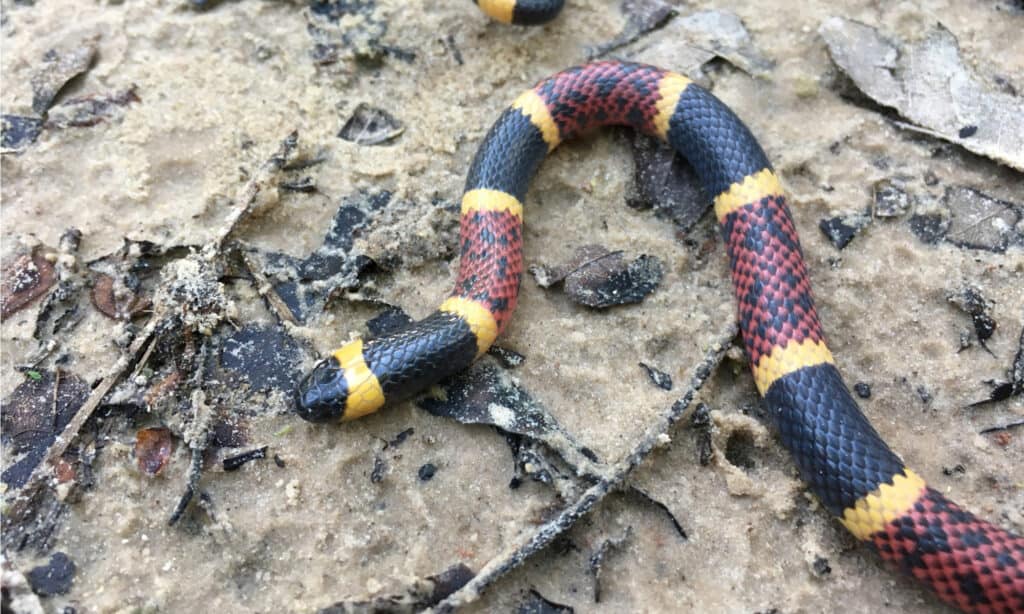
The Texas coral snake has the most toxic venom of any snake in the Lone State State.
©Joe Farah/Shutterstock.com
Snakebites in Texas
On average, one to two people die each year in Texas from a venomous snakebite. For perspective, nearly ten people were killed in Texas traffic accidents every single day in 2021.
Snake Season in Texas
Snakes in Texas emerge from their brumation in late February or early March. They re-enter brumation anywhere from September to December, depending on the temperature. In warmer regions, snakes will enter brumation later and emerge earlier than in cooler areas.
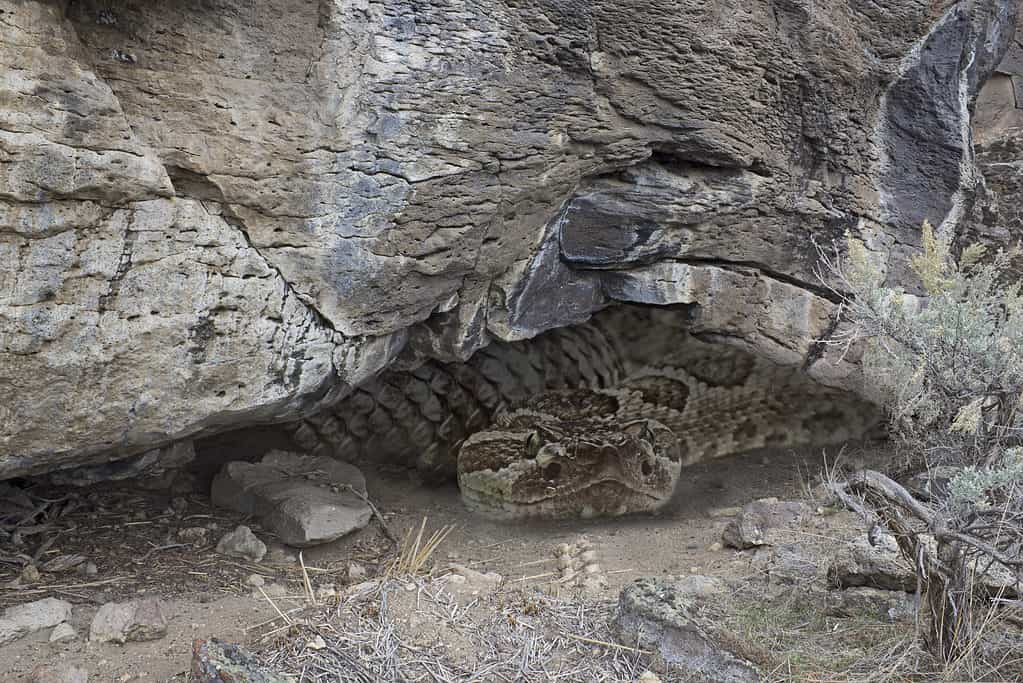
Most Texas snakes emerge from brumation in February or March.
©Ginger Livingston Sanders/Shutterstock.com
The Importance of Snakes
Predators are always important to the ecosystems where they are found, and snakes are no different. They are critical to keep the populations of their prey in check.
All snakes are carnivores. Depending on the species, they eat everything from insects to amphibians to other reptiles to fish, to mammals. Snakes often predate rodents, a trait for which humans ought to be very grateful. Along with being unwelcome and destructive guests in homes and other areas frequented by people, rodents can carry a whole host of diseases. Snakes are critical predators that keep the rodent population from exploding.
The predator can also become the prey. Some snakes, especially smaller species, are important prey for birds, fish, mammals, and other reptiles.
As both predator and prey, snakes are vital for the health of the food web in their native ecosystems.
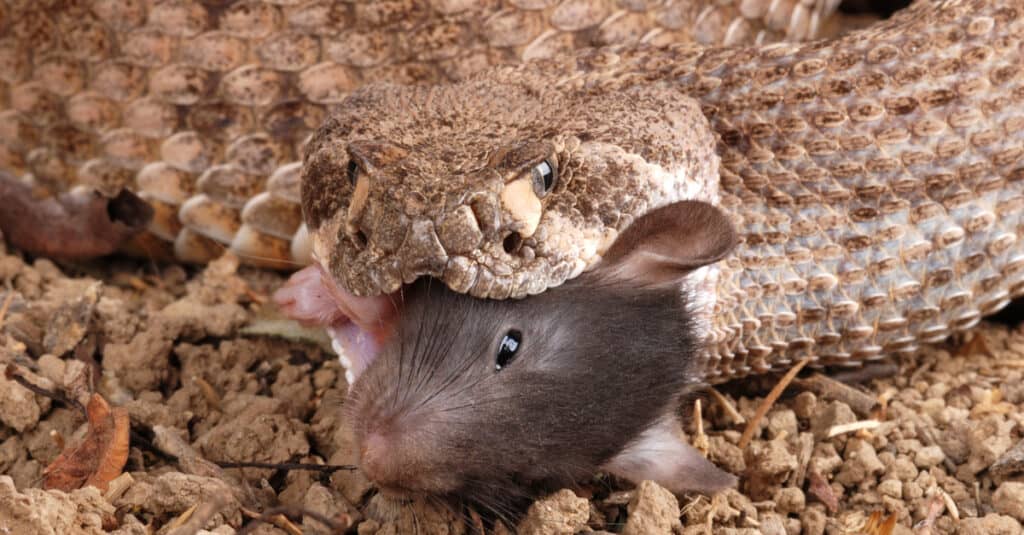
Western diamondback
rattlesnakes
are vital to rodent control.
©Audrey Snider-Bell/Shutterstock.com
How to Avoid Snakebites
The Texas Panhandle Poison Center offers the following tips to greatly reduce the chances of incurring a snakebite.
- Avoid places where snakes may live, including tall grass or brush, rocky areas, fallen logs, bluffs, swamps and marshes, leaves, and deep holes in the ground.
- Watch where you step and where you sit when outdoors.
- Never handle a snake, even if you think it is dead. Recently killed snakes may still bite by reflex. If you plan to spend time in a snake-prone area, it’s best not to go alone in case a snake bites you or you have another emergency. If you must go alone, make sure you bring a fully-charged mobile phone and remain within your phone’s signal area.
- When moving through tall grass or weeds, poke at the ground in front of you with a long stick to scare away snakes.
- Shine a flashlight on your path when walking outside at night.
- Wear long pants and sturdy closed-toe shoes when spending time outdoors.

Long pants and closed-toe shoes such as boots are the best choices when walking through a snake’s habitat.
©Eugene Troskie/Shutterstock.com
Symptoms of a Venomous Snakebite
It is impossible to predict exactly how a person’s body will react to a venomous snakebite. A myriad of environmental and biological factors can influence the effects of envenomation. While there is no way to know how an individual will respond immunologically to a venomous snakebite, here is a list of potential symptoms from Texas Health and Human Services. It is unlikely that a snakebite victim will exhibit all of these symptoms, but any sign of one or more of them signal that immediate medical attention is required.
- Blurred vision
- Convulsions
- Dizziness
- Excessive sweating
- Fainting
- Fang marks
- Fever
- Increased salivation
- Localized pain and burning
- Muscle contractions
- Muscle incoordination
- Nausea and vomiting
- Numbness and tingling
- Rapid pulse rate
- Skin discoloration
- Swelling in the bite area
- Thirst
- Tissue death
- Weakness
What Should You Do if You Are Bitten By a Snake?
Even if you take all the proper precautions, snakebites can still happen. If you do suffer a snakebite, the Georgia Poison Center offers these important dos and don’ts.
DO
- Keep still and stay calm
- Remove all jewelry and tight clothing
- Note the color and shape of the snake and what time the bite happened
- Wash the bite with soap and water and cover the bite with a clean, dry dressing
- Call 9-1-1 or your local poison control center
DON’T
- DO NOT pick up the snake or try to trap it
- DO NOT apply a tourniquet or attempt to restrict blood blow to the affected area
- DO NOT cut the wound
- DO NOT attempt to suck out the venom
- DO NOT apply heat, cold, electricity or any substance to the bite
- DO NOT drink alcohol or caffeinated beverages
- DO NOT take any drugs or medicines
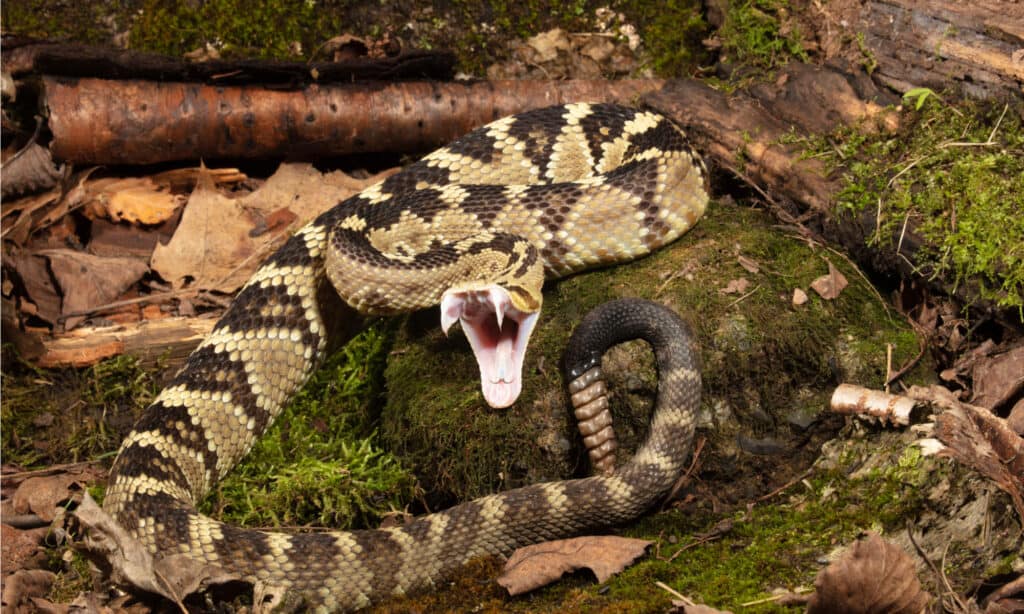
It’s important to know the dos and don’ts of snakebite treatment before venturing into snake-prone areas.
©Joe McDonald/Shutterstock.com
Venomous Snakebites in the United States
Around 7,000 people are bitten by venomous snakes in the U.S. every year. However, only 0.2% (1 out of 500) of those bites are fatal.
The photo featured at the top of this post is © Joe McDonald/Shutterstock.com
Discover the "Monster" Snake 5X Bigger than an Anaconda
Every day A-Z Animals sends out some of the most incredible facts in the world from our free newsletter. Want to discover the 10 most beautiful snakes in the world, a "snake island" where you're never more than 3 feet from danger, or a "monster" snake 5X larger than an anaconda? Then sign up right now and you'll start receiving our daily newsletter absolutely free.
Thank you for reading! Have some feedback for us? Contact the AZ Animals editorial team.






